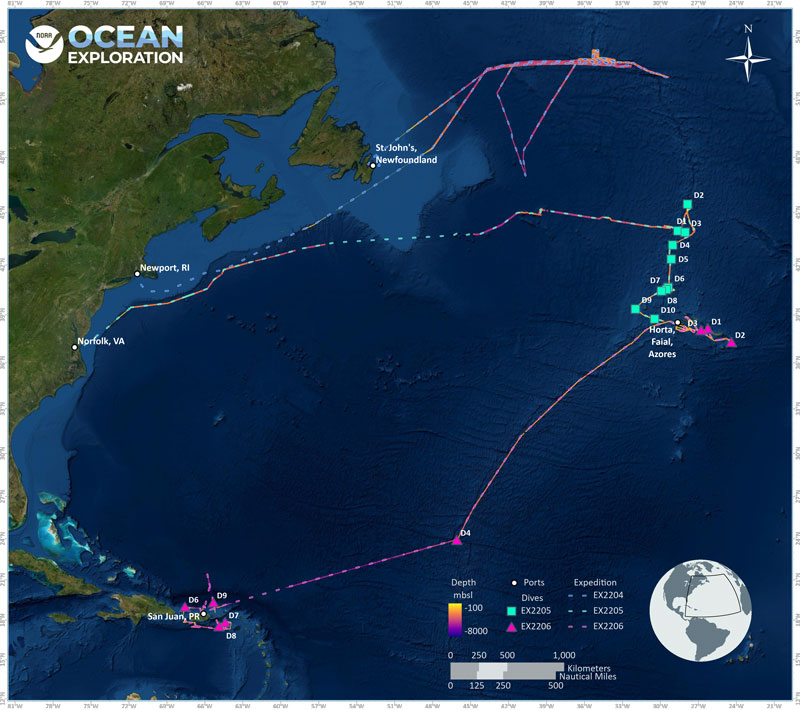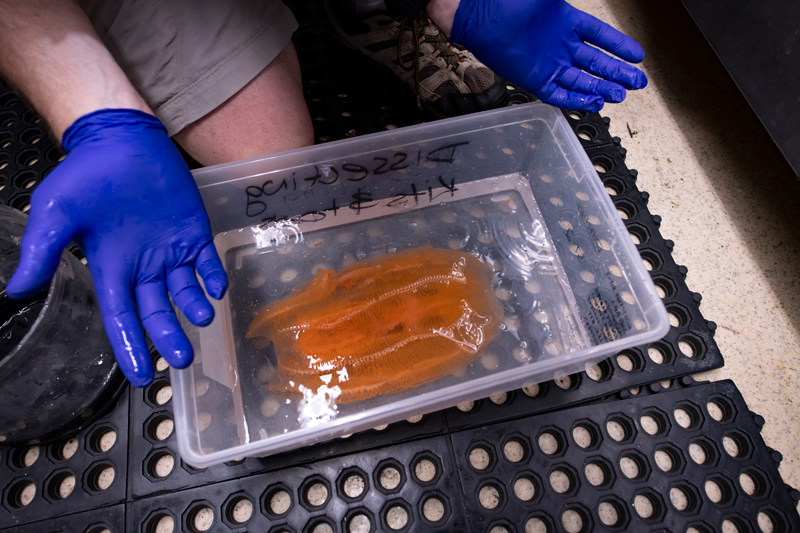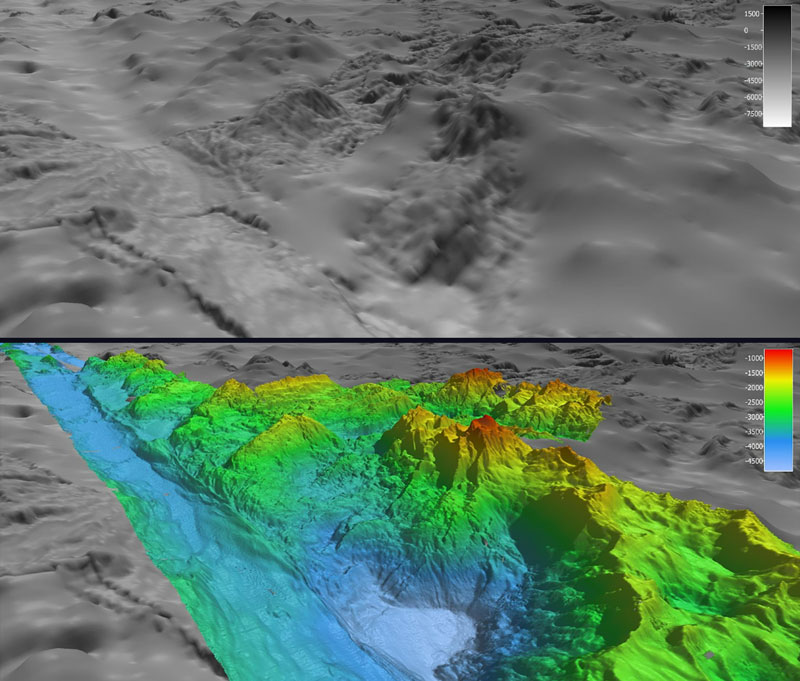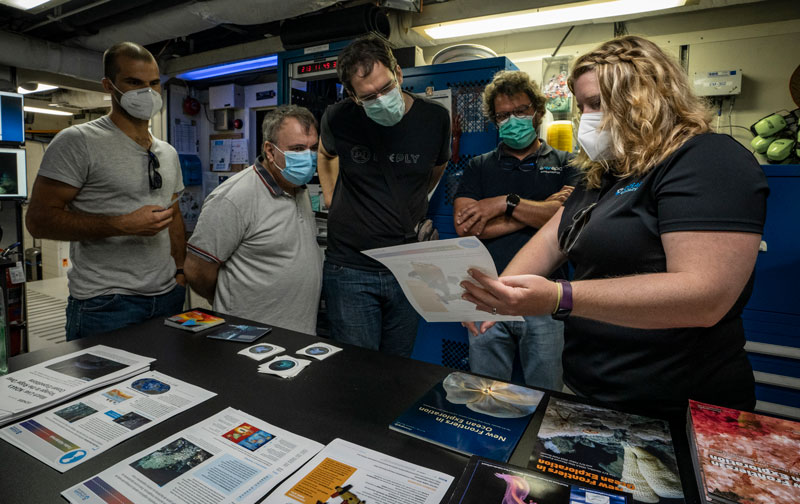Voyage to the Ridge 2022
May 14 - September 2, 2022
Expedition Summary
Voyage to the Ridge 2022 Summary
May 14 - September 2, 2022
Voyage to the Ridge 2022 was a series of three telepresence-enabled ocean exploration expeditions on NOAA Ship Okeanos Explorer that totaled 74 days at sea. Mapping operations and remotely operated vehicle (ROV) dives focused on the collection of baseline information about unexplored and poorly understood deepwater areas of the Charlie-Gibbs Fracture Zone, Mid-Atlantic Ridge, and Azores Plateau. A series of dives in deepwater areas in the vicinity of Puerto Rico and the U.S. Virgin Islands also built off previous work done by NOAA Ocean Exploration in the region in 2015, 2018, and March and April 2022.
Major Voyage to the Ridge 2022 accomplishments are summarized below. For more information, download the summary fact sheet (pdf, 2 MB).
Operational Summary

- Expeditions: 3
- Days at sea: 74
- ROV dives: 19, ranging in depth from 347 to 6,012 meters (1,138 to 19,724 feet)
- Biological samples collected: 66 primary samples, 141 associates
- Geological samples collected: 23
- Water samples collected for eDNA analysis: 86
- Seafloor area mapped: over 152,430 square kilometers (58,854 square miles)
- Science party participants: +170, from 7 countries
- Live video views: +184,500
Biological Discoveries: New Observations, New Records, New Species
During the second and third Voyage to the Ridge 2022 expeditions, observations made using ROV Deep Discoverer yielded several discoveries and uncovered a few mysteries. During the second and third expeditions we observed, on three separate dives on the Mid-Atlantic Ridge and Azores Plateau, several sublinear sets of “mysterious” holes in the sediment on the seafloor. While the holes look almost human made, the little piles of sediment around them suggest they had been excavated and their origin remains unknown. An unidentified blue organism, affectionately referred to as the “blue goo,” was seen multiple times during a dive southwest of St. Croix. Scientists think it may be a soft coral, sponge, or tunicate...but at the moment, its identification remains a mystery. Both of these discoveries not only stumped participating scientists, but they also captured the interest and imagination of thousands of members of the general public, who shared their own hypotheses via social media.
During ROV dives, the team collected both biological and geological samples, adhering to the sampling objective for expeditions on Okeanos Explorer of collecting a limited number of samples in order to characterize a dive location. Several of these biological samples potentially represent new species of glass sponges, plexaurid sea fans, ctenophores, and many other taxa. Additionally, we documented several potential range extensions of marine organisms, including the easternmost observation of a rock pen and possibly the first Atlantic record of a coprophagous snail on a crinoid while exploring a prominent axial valley ridge in international waters north of the Azores.

Deep-sea (cold-water) corals and sponges were observed on 18 dives conducted during the second and third Voyage to the Ridge 2022 expeditions, with 6 of the dive sites exhibiting high diversity. One exciting find was the discovery of an extensive reef of brightly colored yellow coral in the genus Eguchipsammia living on top of dead coral rubble while exploring an unnamed seamount on the western flank of the Mid-Atlantic Ridge rift valley, within the OSPAR Mid-Atlantic Ridge North of the Azores (MARNA) marine protected area. Scientists hypothesize that these kinds of reefs may be more common along the Mid-Atlantic Ridge than previously thought.
Collectively, these visual observations and biological samples will help scientists to characterize specific dive locations while also increasing our overall understanding of the ocean ecosystem in the region and of deep-sea ecosystem connectivity across the Atlantic basin.
Mapping Highlights
All three Voyage to the Ridge 2022 expeditions involved mapping operations, with the first expedition being dedicated solely to the collection of acoustic data of seafloor and sub-seafloor geomorphology and water column habitats of the Charlie-Gibbs Fracture Zone on the Mid-Atlantic Ridge. All told, over the course of the three expeditions the team mapped more than 152,430 square kilometers (58,854 square miles) of seafloor – an area larger than the state of Florida. This included the largest continuous mapping survey effort to date over the Charlie-Gibbs Fracture Zone, collecting bathymetric data along this geologically fascinating and ecologically exceptional region. Additionally, the team mapped several new mound features in the North Atlantic that were previously unmapped and unknown.

Engaging the Scientific Community and the Public
Telepresence technology on NOAA Ship Okeanos Explorer allows shore-based scientists and managers to fully engage in an expedition. Throughout Voyage to the Ridge 2022, more than 170 scientists, resource managers, and students actively participated from around the world, including representatives from Canada, Portugal, Japan, Norway, Italy, and the United Kingdom.
The same technology that brought live video to scientists on shore also enabled members of the public to experience deep-sea exploration and the wonders of science and discovery in real time. During Voyage to the Ridge 2022, we engaged with audiences around the world, opening a window of understanding into the deep ocean through several live interactions, live video feeds that received more than 184,000 views, expedition web content, and more than 500 media/web stories.
Additionally, 29 local stakeholders were able to tour Okeanos Explorer and learn more about Voyage to the Ridge 2022 and NOAA Ocean Exploration’s mission and objectives while the ship was in port in Horta, Azores. And, keeping with the office’s goal of training the next generation of ocean explorations, three students participated in the first Voyage to the Ridge 2022 expedition as Explorer-in-Training interns.


Collecting and Sharing Data
Data collected during Voyage to the Ridge 2022 will inform initial characterization of the areas visited and include multibeam, single beam, sub-bottom, ADCP (acoustic Doppler current profiler), XBT (expendable bathythermograph), CTD (conductivity, temperature, and depth), and dissolved oxygen profiles; surface oceanographic and meteorological sensors; video and imagery; and physical specimens. All data from this expedition will be publicly available through national archives. A direct link to the expedition data archives will be provided on the Voyage to the Ridge 2022 website once the data are available. For questions or inquiries about this series of expeditions, please email ex.expeditioncoordinator@noaa.gov.
Voyage to the Ridge 2022 was NOAA Ocean Exploration’s final contribution to NOAA’s Atlantic Seafloor Partnership for Integrated Research and Exploration (ASPIRE) campaign and represented a major contribution to the Galway Statement on Atlantic Ocean Cooperation and the Atlantic Ocean Research Alliance’s deep-sea mapping and exploration efforts.